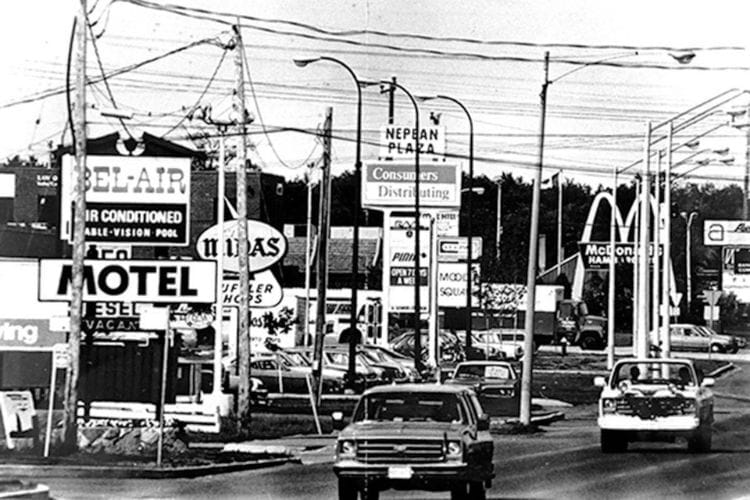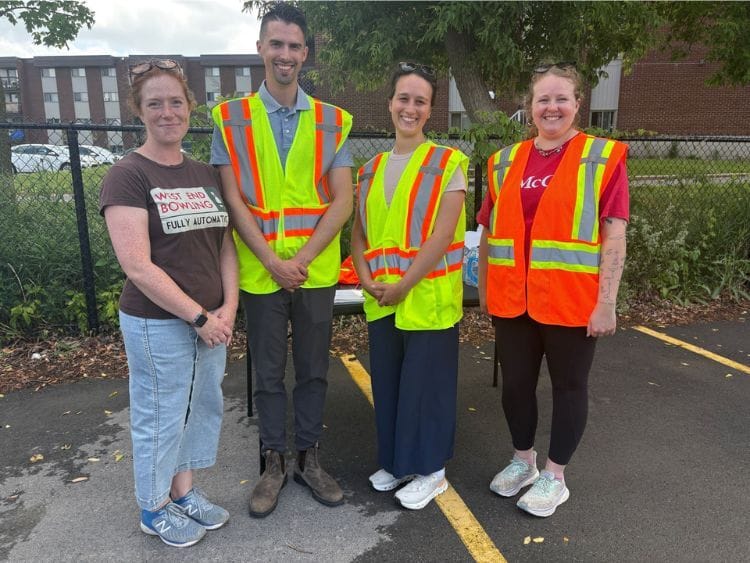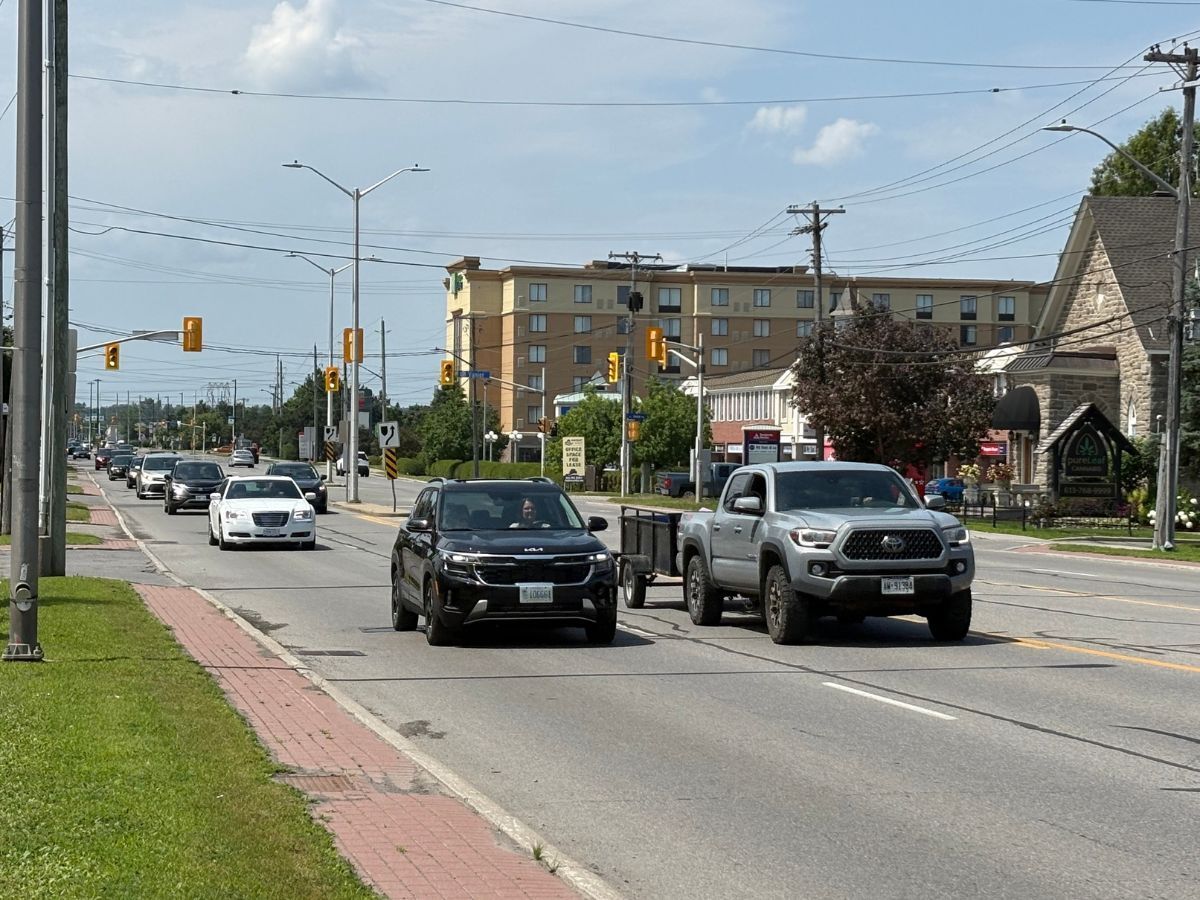For decades, Bells Corners has grown by adapting to the changing times—new highways, waves of suburban housing development and the rise of big-box retail. Each shift reshaped the community, pulling it further from the small rural stopover it had been in the 19th century to a major commercial node built around traffic and evolving consumer needs.
At the center of that evolution has been Robertson Road. The corridor has carried several names over the years, but it ultimately took its name from John Robertson, a local general store owner and Nepean Township’s long-serving “surveyor of roads.”

Looking west along Robertson Road towards Moodie Drive in the 1980s. Credit: City of Ottawa Archives CA025336
Today, it acts as a main street for the neighbourhood of 10,000 and surrounding communities, which also rely on the western suburb to shop for groceries, attend medical appointments, or eat out. But the road is showing its age, and the Bells Corners community has long been advocating for more investment and improvement.
That is why College Ward Coun. Laine Johnson has launched the Reimagining Robertson Road Study. A survey with more than 300 respondents found there is a desire for safer spaces to walk or bike, better transportation options, and increased gathering spaces.
She wanted to make sure the community's needs were being addressed “in the absence of formal city plans,” Johnson said. With new zoning amendments promoting development, she said it was important to create a framework before development applications are brought forward.
“Bells Corners overall has not seen a lot of density changes. It is single-family homes and geographically, it can be a bit isolated,” Johnson told the Lookout. “The city often only looks at places that are growing, in terms of units and homes.
“But part of that challenge is many young families have moved in, and there are lots of kids now trying to move through the neighbourhood. But there are also a lot of seniors who want to stay in Bells Corners but don't have the option to downsize,” she explained. “So we need to have some diversity of housing options.”

College Ward Coun. Laine Johnson (left) said the Robertson Road study is important to ensure Bells Corners received enough support from the city. Provided photo.
While large-scale development has been slow to come to Bells Corners, there are a few projects planned; Stillwater Station, a 32-storey condo containing around 2,000 units, is planned at 1987 Robertson Road, but has faced delays getting through the Planning and Housing Committee.
And while there are no formal plans announced yet, Johnson also anticipates new tenants will move into the strip mall near Robertson Road and Moodie Drive. A pickleball court is currently under construction in the former Zellers retail spot and new businesses could also soon be built in the parking lot, possibly bringing further densification with them.

The former Zellers store in Bells Corners is being converted into a pickleball court. Photo by Charlie Senack.
“They're not in a position to be able to do housing there with Loblaws as the tenant, so they are interested in putting in commercial tenants and investing in the property — which is fabulous because it's just so dead,” said Johnson. “Other tenants should be announced within the next calendar year. A pipe first needs to be fixed in the parking lot.”
Advocating for equal business supports
Christine Leadman is no stranger to how business works in Ottawa. She was a city councillor in Kitchissippi Ward for one term, and served as executive director of the Centretown and Glebe BIAs. Two years ago, she also took on that role at the Bells Corners BIA and said her number-one goal was to ensure the Nepean suburb got the same kind of attention as its urban neighbours.
“As long as I have been working in local BIAs, which is now over 30 years, I have never seen any investment in Bells Corners,” Leadman told the Lookout.
Leadman is in support of the Robertson Road study and said she hopes it will bring some fairness to the city. She would like to see more beautification projects in Bells Corners, whether it be greenery, art installations, benches, or lights on trees.
In order to do that, Leadman also believes Ottawa needs to increase investment in local business improvement associations. Currently, the city has a $262,000 a year budget for its 18 BIAs.
Much of that money is spent for BIAs to help remove graffiti; the Bank Street BIA received $21,750 in 2021 to remove the unwanted illegal artwork, with the Downtown Rideau BIA receiving $36,000 that same year. In comparison, Leadman says the Bells Corners BIA spends only about $250 a year to remove graffiti.
There are also inconsistent rules for City investment in for large-scale community projects, says Leadman. While working in Westboro in the 1990s, she helped get street lighting, but it had to be paid out of pocket by the local business community.
When Leadman then helped spearhead a similar movement to bury hydro wires in the Glebe over a decade later, the city picked up the bill because Lansdowne 1.0 was currently under construction on the same street. In 2011, Centretown also did rehabilitation work, and had a portion paid by the federal government, but had to pay for the rest.
“Preston Street later was charged the amount but appealed it and the city refunded them the money,” said Leadman. “When I came on board with Centretown, I approached the city to get our money back because they were paying for all these other areas, but they said it's too late. There are inconsistencies in the services the city pays for.”
The city later took over responsibility of the electrical service along Bank Street.
But Leadman said she would like to see Bells Corners receive more attention from the city, especially given the amount of thoroughfare traffic the community receives with the expansion of surrounding areas like Stittsville and Kanata.
“Whether it's a freestanding structure or a mural of some kind, I don't have the opportunity to do that in my area,” she said. “The city also does not help out with festivals in any form which are small and free for the community, but give grants to ticketed events like BluesFest.”
With city support and innovative ideas, Leadman said she would like to see Bells Corners reinvisioned in the next decade to include cycle lanes piloted on Robertson Road, better sidewalk crossings for seniors, and consistent speed limits. Currently, Robertson Road switches between 60 km/h and 80 km/h.
A design rendering of Robertson Road with ideas displayed from the survey will be produced this winter, followed by a final report that will be drafted in the spring.
“I think there's lots of opportunity, but there also has to be recognition on the city that Bells Corners is a viable, valid community to invest in,” said Leadman. “We have three grocery stores out here, a lot of health providers, services that our community and others value.
“The province has special funds for agricultural rural communities like Manotick. Why don't we have something similar to address the specific needs of suburban areas?”




